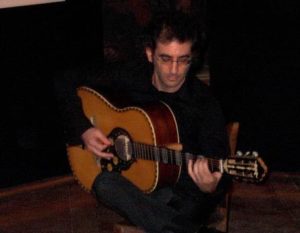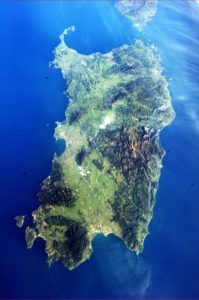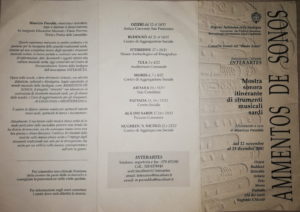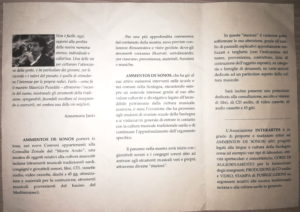PARISTORIA
PARISTORIA
“… fundamental was the collaboration of the musician Maurizio Puxeddu who created the sound effects and composed the original music, which support the entire stage set, created following the evolution of the show, interacting with it to ensure that creativity was in total harmony with the individual scenes. ”
Gianfranco Angei (director)

Copyright © Maurizio Puxeddu (2002)
Notes on music
The musical work for the show PARISTORIA has drawn fully on the research I have been doing in Sardinia (for over fifteen years now) on the ethnic musical instruments of our island culture. In this research there are two main strands: the first relating to the recovery of tradition, the second based on innovation. Some results, finding a natural harmony with the work of the Actores Alidos, have therefore flowed into the realization of the music necessary for the show in question.
Sardinian instruments, like my original music, not forgetting the accumulation of cultures with which the Sardinians have dealt, adhere (I don’t like to say that they bend) to the needs of the scene, suggesting resolutions or emphasizing magical settings, supported by other ethnic Mediterranean instruments and electronic instruments: launeddas, sulittu, benas ‘e corru, tumbarinu’ and Gavoi, triangulu, ischiglittos, pitiolus, crocorigas, darbuka, bendir, accordion, piano, transverse flutes, synthesizers, are all the tools used in this work.

And then, incredibly, the sound of su sulittu, the reed flute of Sardinia, weaving memories of distant melodies, in the scene of the Sartiglia, it hisses and winds, or, by choice, but it seems almost by scenic suggestion, horse neigh .
The launeddas that traditionally play in “major”, cheerful and joyful, for the scene of the Duel and the Love Encounter, in order to make the atmosphere dramatic through the “minor key”, are modified by combining different “reeds” coming from different cunzertu.
Dreamy atmospheres also for the Dance of the torches where su tumbarinu ‘and Gavoi, played with an unconventional technique (i.e. hitting the skin membrane with your fingers), creates a sound carpet, together with piano and synthesizer, on which rests the melody of a transverse flute with a soft sound.

But sometimes the compositional wisdom has to step aside, leaving room for noise and sound effects. The job of the composer musician becomes a balancing act, a matter of taste in the choice of the piece of ambient noise to be used, in the editing of the various recordings, cut and glued thanks to the computer, until it becomes what seems normal to us when listening. “worked”.
It was fun to record the crickets in Sant’Isidoro, going specifically to interview these cute little animals, or the voices of children, in a kindergarten in Cagliari, unaware of their theatrical audio debut.
Maurizio Puxeddu (composer)
Launeddas in B’at una femina by Piero Marras
B’AT UNA FEMINA from TUMBU
by Piero Marras
Launeddas: Maurizio Puxeddu
Also in the song B’at una femina (musical album TUMBU – 1995), Piero Marras wanted the launeddas to color a part of the song, making me use the launeddas in a different way from the classic and traditional one. Find out where in the song launeddas can be heard.
Launeddas in Sa oghe ‘e Maria by Piero Marras
SA OGHE ‘E MARIA from TUMBU by Piero Marras
Launeddas: Maurizio Puxeddu
In Sa oghe ‘e Maria, the piece by Piero Marras dedicated to the famous Sardinian singer Maria Carta, in the music album TUMBU, I played launeddas, inventing and improvising melodic lines that adapted to the harmonies of the song, not always in keeping with the possibilities traditional launeddas. Find out where in the song launeddas can be heard.
Su corru ‘e boe in Tumbu by Piero Marras
ISTRALES from TUMBU
by Piero Marras
Corru ‘e boe: Maurizio Puxeddu
In 1994/95 I received a phone call from Piero Marras. Those were years in which I carried out intense dissemination activities in schools and municipalities in Sardinia with the exhibition / conference of traditional Sardinian and Mediterranean instruments called “AMMENTOS DE SONOS – Mostra sonora itinerante di strumenti musicali sardi”. Piero asks me to participate with traditional Sardinian instruments in the recording of some sounds for his next record work. I bring the instruments, a small representation, in the recording studio in Sassari and Piero seeing the ox horn, su corru ‘e boi, he chooses to insert it as the first sound of the album TUMBU in the track ISTRALES. Here is the track.
ISLANDS – Musical performance by Maurizio Puxeddu for ILLADOR
ISLANDS – Musical performance by Maurizio Puxeddu
Traditional Sardinian musical instruments used: launeddas, sulittu, bena, bena ‘e corru, ghitarra, corru marinu, trunfa, pitiolus, ischiglittos
It is an initiative created within the ILLADOR photographic exhibition by Marina Anedda, set up in suggestive contexts.
“Retracing the places described by the German philosopher Ernst Jünger, who in 1954, during a trip to Sardinia, stopped in Villasimius, fascinated by the primeval essence of the place, the author of “Illador”, through intense photographic research he autonomously reinterprets the the work of the philosopher, using black and white to prevent the use of color from altering the philological sense of the operation.”
From www.emigratisardi.com
SPOLETO – 12 July 2002
in conjunction with the Festival of Two Worlds
TORTOLI ‘ – September 14, 2002
Museum of Contemporary Art Su Logu De S’Iscultura

Spoleto – Maurizio Puxeddu with sardinian guitar
A text of almost twenty years ago, from 2002, accompanying the performance.
INSULAE
Il primo pensiero va’ all’acqua.
Che lambisce le terre.
Acqua di mare duro contro la roccia.
Instancabile nel sovrumano scontro all’ultimo grano di materia,
all’ultima goccia di lagrima salina.
Dove l’abisso si prende la rivincita,
su quei natali incandescenti ed infuocati.
Di eruzioni e di lave.
Fumanti di liquido esalato.
Con molta calma, dando tempo al tempo.
Nei secoli e nei millenni. Erodendo.
Perché la roccia, ormai raffreddata,
immobile,
non può fuggire e avere scampo.
L’acqua. Trova la sua vendetta.
Nelle isole il tempo è un altro.
Scoprendole sulla linea del tramonto
mutano in approdo di cabotaggi stanchi.
Riferimento per navigatori di antiche rotte.
Salvagente
nella perdita dell’orizzonte liquido.
Poi si aprono mondi interni.
Possibili spazi limitati e limitanti,
ma profondi di conoscenza del se.
Dove scavare interiormente.
Quelle più piccole,
si contengono in uno sguardo.
La loro storia, in un pensiero,
in una sensazione.
Dalla creazione all’oggi.
Quelle più grandi,
ricche di storie tortuose,
riempiono i polmoni di vento profumato.
Generose di sole.
Ma tutte hanno il sentore
della condivisione
della particolare condizione geografica con gli altri, che vivono in altre isole.
Solitudine e separazione,
mista a condivisione.
Situazione ricercabile.
Consapevolezza del non essere solo.
Nelle isole il tempo è un altro.
Ma il primo pensiero va’ all’acqua.
Che lambisce le terre.
M.P.

Ammentos de sonos – Traveling sound exhibition of Sardinian musical instruments
AMMENTOS DE SONOS (Memories of sounds)
Traveling sound exhibition of Sardinian musical instruments
with demonstration conferences and guided tours
Regione Autonoma della Sardegna
Assessorato alla pubblica Istruzione,
Beni Culturali, Informazione, Sport e Spettacolo
Consulta Zonale del “Monte Acuto”
Associazione INTERARTES
Set up by Maurizio Puxeddu
from November 12 to December 23, 2001
Ozieri, Buddusò, Ittireddu, Ardara, Tula, Mores, Pattada, Alà dei Sardi, Nughedu S.Nicolò
Today it is not easy to oppose the loss of our historical, individual and collective memory. One of the ways to capture the attention of people, and in particular of young people, for the events and values of the past, is to stimulate their interest in their roots. Doing it – as the master Maurizio Puxeddu does – through the enchantment of sound, showing the traditional instruments, explaining them, making them listen and teaching them to build them, seems to me one of the best ways.
Annamaria Janin
AMMENTOS DE SONOS will bring on tour, in the nine municipalities belonging to the Zonal Council of “Monte Acuto”, an exhibition of objects related to the island’s musical culture (traditional Sardinian musical instruments, devices and sound toys, books, CDs, audio cassettes, video cassettes, 45 discs days, construction equipment and materials, musical instruments from the Mediterranean basin).
For a more in-depth knowledge of the content of the exhibition, demonstration conferences and guided tours are provided, where the tools will be illustrated, highlighting for each one, origin, materials, functions and music.
AMMENTOS DE SONOS, which already has numerous interventions in schools and municipalities in Sardinia, always attracting considerable interest thanks to its high cultural and popular value linked to the incredible heritage of our local musical culture, was the opportunity that allowed students of various schools in Sardinia and visitors in general to get in touch with traditional Sardinian culture or to continue the study of the specific topic.
The path in the exhibition will begin with sound toys and sound devices up to the actual musical instruments, through different “stations”.
In these “stations” the visitor will be able to focus his attention, thanks to the help of specially made explanatory panels and plates (with indication of the name, origin, manufacturer, date of construction of the exhibited object), on categories of instruments, on various sections dedicated to a particular aspect of musical culture.
There will also be a workstation dedicated to consulting, listening and viewing of books, audio CDs, video cassettes, audio cassettes and 45 days.
The INTERARTES Association is able to propose and implement (in addition to AMMENTOS DE SONOS) other projects related to the language and culture of Sardinia such as various types of workshops, spectacular and concert activities, UPDATE COURSES for teacher training, PRODUCTIONS of audio and VIDEO CDs, PRINT of PUBLICATIONS on topics related to traditional music and Sardinian culture in general.
To allow optimal use of the exhibition by school groups, it is recommended to book guided tours.
From the brochure of the initiative


